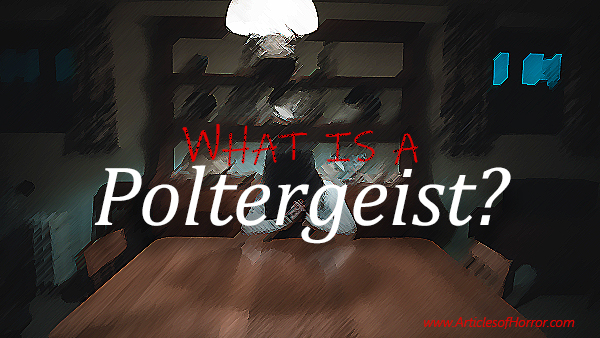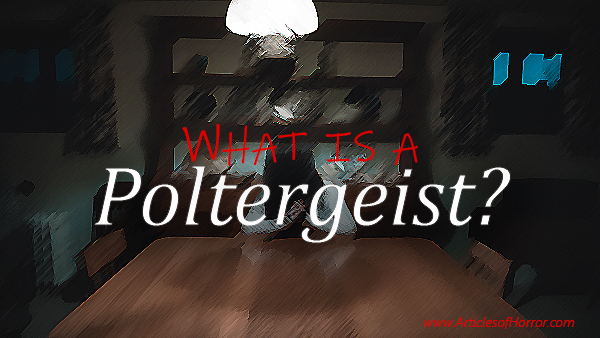
Chances are, if you’re into scary movies and spooky books, you’ve heard of the ‘Poltergeist’. Belonging in the realm of folklore, the legend of the poltergeist has been passed down to new skeptics and believers as early as the first century. Tales of this strange phenomena are widespread, touching upon both eastern and western civilizations.
pol·ter·geist
ˈpōltərˌɡīst/
noun
-
a ghost or other supernatural being supposedly responsible for physical disturbances such as loud noises and objects thrown around.
The word ‘Poltergeist’ has Germanic roots, and stems from the German word poltern, meaning “to make sound” and geist, or “ghost.”
How does a Poltergeist differentiate itself from the hodgepodge of paranormal phenomena? And what makes it stand out?
One of the biggest characteristics of a Poltergeist is that it is an entity disturbing a specific person(s) rather than a place or thing. It does not assume the body of someone such as a possession, nor is it tied to a place or event like a haunting. Instead, a Poltergeist focuses its energy upon one or more persons, on whom it is set to torment in both big ways and small. This makes for a more troublesome situation, as moving houses will not be rid of the Poltergeist if it chooses to follow. The strange occurrences usually begin innocently enough, causing little to no harm. Over time, however, it is known to become destructive, violent, and more powerful.


The Paranomal Society released an article in 2012 stating, “One very important thing to note is that Poltergeists are not spirits. Instead, theories state that poltergeists are mass forms of energy that a living person is unknowingly controlling. Poltergeist hauntings may be the most misunderstood, most terrifying, and one of the rarest types of hauntings. Some researchers and parapsychologists believe that poltergeist hauntings are not even a haunting at all.”
Since 1915, nearly 40 films have been released with the word ‘Poltergeist’ in its title. The earliest of these was German film Der Geisterseher by director Waldemar Hecker. However, it was the 1982 release of blockbuster Poltergeist by director Tobe Hooper that grappled audiences with the nature of this frightening and troublesome experience and caused an upswing in widespread interest in the subject. The success of the first film led to two more in the franchise.
The films brought audiences into the homes of a Poltergeist disturbance, where object could instantaneously fly out of cupboards and papers flung into the air, chairs effortlessly levitate and, in the worse case scenarios, knives flung against walls.
“Harry witnessed Professor McGonagall walking right past Peeves who was determinedly loosening a crystal chandelier and could have sworn he heard her tell the poltergeist out of the corner of her mouth, ‘It unscrews the other way.” ― J.K. Rowling, Harry Potter and the Order of the Phoenix
Aside from fiction, accounts of real life Poltergeists are numerous. From them, we are able to draw examples of a Poltergeist behavior. Some of the most famous cases include the Bell Witch of Tennessee, The Rosenheim Poltergeist, and the Enfield Poltergeist.
Real Poltergeist Cases:
-
The Bell Witch of Tennessee – During the early 1800s in Robertson County, Tennessee, a farmer by the name of John Bell and his family suddenly came under attack of a malicious entity of which they could not see nor predict. It was one of the first cases of a claimed Poltergeist to have been so thoroughly documented via first-hand witnesses in books and newspapers. Beginning in 1817, members of the family and slaves began seeing apparitions of creatures. The creature would present itself differently each time, once as a dog and another time as a little girl in a green dress. Soon, strange noises were heard inside the home. Knocking on walls and floors, snarling, dragging chains. Then the torments increased. Bed sheets were pulled from those sleeping, pinching could be felt and even paralysis of body parts. The case was never closed, as the Bell Witch became the center of dispute for deaths and disturbances for many decades that followed.

-
The Rosenheim Poltergeist – In Rosenheim in southern Bavaria during the late 1960s, a 19-year-old secretary named Annemarie Schaberl was blamed for Poltergeist activity in the law office which she was employed. A string of events, such as exploding light bulbs, moving office furniture, leaking printer and copier fluids and mysterious phone calls that the staff denied making all led to German parapsychologist Hans Bender to point to Schaberl. He reasoned that the young woman had obtained telekinesis powers, a common explanation as it “is an alleged psychic ability allowing a person to influence a physical system without physical interaction.” To prove himself correct, Bender concluded that the activity only ceased in the office once Schaberl left her position to be married.
-
The Enfield Poltergeist – This case was the creative subject of Director James Wan’s The Conjuring 2. Set in Brimsdown, Enfield, England between 1977 and 1979, the strange case revolves around a single mother and her children, particularly two of her daughters, who claimed to have been flung around the room, heavy furniture moving on their own, strange knocking on the walls, and even disembodied voices. The long list of inexplicable phenomena led to much speculation as word spread in the community. Many investigative organizations sought the truth for themselves, such as the Society for Psychical Research and the Committee for Skeptical Inquiry. Major newspapers including the Daily Mirror flamed interest in the Hodgson family. During a 30 month period, more than two dozen witnesses gave testimony that they saw object flying though no person had interfered. Despite the witnesses, however, many have strongly claimed that the girls had been staging the strange happenings.
https://www.youtube.com/watch?v=_JI8Pk1qbfo
Other Explanations:
With a lore this old and vibrant, it is no wonder that so many attempts have been made to prove or disprove the validity of the Poltergeist throughout the ages. A strong theory is “Anomalistic Psychology”, or, “the study of human behaviour and experience connected with what is often called the paranormal, with the assumption that there is nothing paranormal involved.” Telekinesis remains another explanation as many point to cases like the aforementioned Rosenheim case.
But perhaps the most popular explanation can be found in the field of psychology. In a piece for The Guardian, editor of The Skeptic, Deborah Hyde dissects the Enfield Poltergeist. She points out that, “People frequently see what they expect to see, their senses being organised and shaped by their prior experiences and beliefs in a process called ‘top-down processing’.” Hyde tells us that “Inattentional Blindness” could be the cause of suddenly noticing something that was thought not to be there before. Even sleep paralysis can be used as an explanation for sudden loss of control, including breathing and hallucinations.
While skeptics and science may have many theories to explain this paranormal phenomena, questions still remain. To the individuals who have a steadfast belief that what they witnessed themselves cannot be explained by any reason or logic of earthly understanding, for them we keep an open mind.
-by Christina Persaud
Sources:
Der Geisterseher (1915). (1915, May 5). Retrieved from https://www.imdb.com/title/tt0427283/?ref_=nv_sr_2
Hyde, D. (2018, February 14). The Enfield ‘Poltergeist?: a sceptic speaks. Retrieved from https://www.theguardian.com/science/2015/may/01/the-enfield-poltergeist-a-skeptic-speaks
The Legend of the Bell Witch of Tennessee – by Pat Fitzhugh, Author / Historian. (n.d.). Retrieved from http://www.bellwitch.org/story.htm
Poltergeist (1982). (1982, June 4). Retrieved from https://www.imdb.com/title/tt0084516/?ref_=fn_ft_tt_1
Brad Clark (2002). Spiritualism. pp. 220–226 in Michael Shermer. The Skeptic Encyclopedia of Pseudoscience. ABC-CLIO. ISBN 978-1576076538
Lionel Weatherly, John Nevil Maskelyne. (2011). The Supernatural? (Cambridge Library Collection – Spiritualism and Esoteric Knowledge). Cambridge University Press. ISBN 978-1108029193
Storr, Will. (2015). “The Real Story of the Enfield Haunting”. The Daily Telegraph. Retrieved 3 May 2015.
Hoebens, Piet Hein. (1986). Sense and Nonsense in Parapsychology. In Kendrick Frazier. (1986). Science Confronts the Paranormal. Prometheus Books. pp. 28-42. ISBN 978-1-61592-619-0
What is a Poltergeist? (2012, September 4). Retrieved from http://www.theparanormalsociety.org/library/articles/ghosts-hauntings/882-what-is-a-poltergeist
[ajax_load_more post_type=”post” max_pages=”1″]


